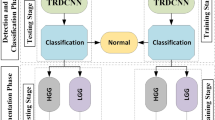Abstract
Astrocytoma is the most common and aggressive brain tumor, in its highest grade, the prognosis is ‘low survival rate’. Spinal tap and biopsy are the methods executed in order to determine the grade of astrocytoma. Once the grade of astrocytoma is determined, treatment is planned to improve the life expectancy of oncological subjects. Spinal tap and biopsy are invasive diagnostic procedures. Magnetic resonance imaging (MRI) being widely used imaging modality to detect brain tumors, produces the large volume of MRI data each moment in clinical environments. Automated and reliable methods of astrocytoma grading from the analysis of MRI images are required as an alternative to biopsy and spinal tape. However, obtaining molecular information of brain cells using non-invasive methods is challenging. In this research work, an automatic method of astrocytoma grading using Convolutional Neural Networks (CNN) has been proposed. Results have been validated on a locally developed dataset, obtained from Department of Radiology (Diagnostics), Bahawal Victoria Hospital, Bahawalpur, Pakistan. The proposed method proved a significant achievement in terms of accuracy as 99.06% (for astrocytoma of Grade-I), 94.01% (for astrocytoma of Grade-II), 95.31% (for astrocytoma of Grade-III), 97.85% (for astrocytoma of Grade-IV), and overall accuracy of 96.56%.


Similar content being viewed by others
References
Bartheld CS, Bahney J, Herculano-Houzel S (2016) The search for true numbers of neurons and glial cells in the human brain: a review of 150 years of cell counting. J Comp Neurol 524(18):3865–3895
Ertosun MG, Rubin DL (2015) Automated grading of gliomas using deep learning in digital pathology images: A modular approach with ensemble of convolutional neural networks. In: AMIA Annual Symposium Proceedings, American Medical Informatics Association, pp 1899–1908
Folkman J (1971) Tumor angiogenesis: therapeutic implications. N Engl J Med 285(21):1182–1186
Gilanie G, Bajwa UI, Waraich MM, Habib Z (2019) Computer aided diagnosis of brain abnormalities using texture analysis of MRI images. Int J Imaging Syst Technol 29(3):260–271
Gilanie G, Bajwa UI, Waraich MM, Habib Z (2019) Automated and reliable brain radiology with texture analysis of magnetic resonance imaging and cross datasets validation. Int J Imaging Syst Technol 29(4):531–538
Gilanie G, Bajwa UI, Waraich MM, Habib Z, Ullah H, Nasir M (2018) Classification of normal and abnormal brain MRI slices using Gabor texture and support vector machines. SIViP 12(3):479–487
Jean-Quartier C, Jeanquartier F, Holzinger A (2020) Open data for differential network analysis in Glioma. Int J Mol Sci 21(2):547
Louis DN, Ohgaki H, Wiestler OD, Cavenee WK, Burger PC, Jouvet A, Scheithauer BW, Kleihues P (2007) The 2007 WHO classification of tumours of the central nervous system. Acta Neuropathol 114(2):97–109
Mankin HJ, Lange TA, Spanier S (1982) The hazards of biopsy in patients with malignant primary bone and soft-tissue tumors. JBJS 64(8):1121–1127
Nyúl LG, Udupa JK, Zhang X (2000) New variants of a method of MRI scale standardization. IEEE Trans Med Imaging 19(2):143–150
Ohgaki H, Kleihues P (2013) The definition of primary and secondary glioblastoma. Clin Cancer Res 19(4):764–772
Pan Y, Huang W, Lin Z, Zhu W, Zhou J, Wong J, Ding Z (2015) Brain tumor grading based on neural networks and convolutional neural networks. In: IEEE Engineering in Medicine and Biology Society (EMBC), 37th Annual International Conference of the 2015. IEEE, pp 699–702
Priya KM, Kavitha S, Bharathi B (2016). Brain tumor types and grades classification based on statistical feature set using support vector machine. In: Intelligent Systems and Control (ISCO), 2016 10th International Conference on. IEEE, pp 1–8
Sajjad M, Khan S, Muhammad K, Wu W, Ullah A, Baik SW (2019) Multi-grade brain tumor classification using deep CNN with extensive data augmentation. J Comput Sci 30:174–182
Siegel RL, Miller KD, Jemal A (2018) Cancer statistics, 2018. CA Cancer J Clin 68(1):7–30
Subashini MM, Sahoo SK, Sunil V, Easwaran S (2016) A non-invasive methodology for the grade identification of astrocytoma using image processing and artificial intelligence techniques. Expert Syst Appl 43:186–196
Tearney GJ, Brezinski ME, Bouma BE, Boppart SA, Pitris C, Southern JF, Fujimoto JG (1997) In vivo endoscopic optical biopsy with optical coherence tomography. Science 276(5321):2037–2039
Tustison NJ, Avants BB, Cook PA, Zheng Y, Egan A, Yushkevich PA, Gee JC (2010) N4ITK: improved N3 bias correction. IEEE Trans Med Imaging 29(6):1310–1320
Weiss S, Langloss J, Enzinger F (1983) Value of S-100 protein in the diagnosis of soft tissue tumors with particular reference to benign and malignant Schwann cell tumors. Laboratory investigation; a journal of technical methods and pathology 49(3):299–308
Author information
Authors and Affiliations
Corresponding author
Additional information
Publisher’s note
Springer Nature remains neutral with regard to jurisdictional claims in published maps and institutional affiliations.
Rights and permissions
About this article
Cite this article
Gilanie, G., Bajwa, U.I., Waraich, M.M. et al. Risk-free WHO grading of astrocytoma using convolutional neural networks from MRI images. Multimed Tools Appl 80, 4295–4306 (2021). https://doi.org/10.1007/s11042-020-09970-8
Received:
Revised:
Accepted:
Published:
Issue Date:
DOI: https://doi.org/10.1007/s11042-020-09970-8




